The Oktoberfest (the name in Munich is Wiesn) is the largest folk festival in the world. It has been held on the Theresienwiese in the centre of Munich for about 200 years. The number of visitors is currently about 6 million per year. The total turnover is almost one billion Euro. This makes the Wiesn one of the most important seasonal employers in Germany. Many thousands of people have a mostly well-paid job during the Oktoberfest.
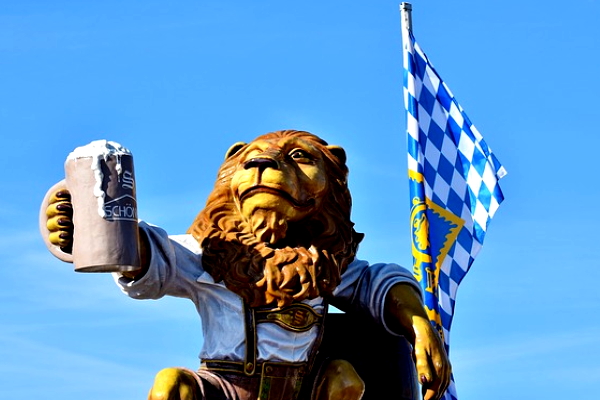
Best time to visit / Overcrowding: Since the area is not even 0.5 km², the fairground is often completely overcrowded. Therefore, it is better to visit the biggest party in the world during the week during the day – at least if you want to see the beer tents from inside. From about 6 pm on weekdays and from 1 pm on Saturday and Sunday the festival tents are usually closed due to overcrowding. The tent capacity is „only“ about 80,000 places in total.
Beer tour Munich: Great city tour with a guide through Munich on the topic of beer, beer halls, breweries, wheat beer including a stay in beer halls and 2 free beers. In the evening, duration 3.5 hours. Be sure to book online, very popular: More information and booking
|
Day excursion from Munich There are great day tours by bus to the world famous Neuschwanstein Castle from Munich. The best tour also stops at other famous places in the area like Linderhof. |
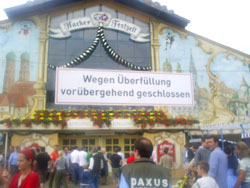
History: The first Oktoberfest took place in October 1810. It was the wedding celebration of the later King Ludwig I of Bavaria, who married Princess Therese (hence the name Theresienwiese). In the course of the years the festival grew bigger and bigger, soon showmen were added. The saddest event was the bomb attack in 1980, in which 13 people died. The assassin was probably a Bavarian right-wing extremist who himself died in the bombing.
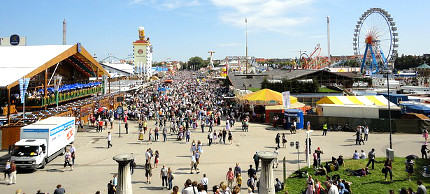
Dates: Since the weather is worse in October, the festival was moved to September over 100 years ago. It always starts on a Saturday at 12 noon, lasts between 15 and 17 days and ends at the beginning of October. If the holiday of German Unity Day (October 3rd) is a Monday or Tuesday, the festival ends on that day. In other years it continues until the first Sunday in October.
According to my calculations, the Oktoberfest should take place at the following time:
2024: September 21st until 6.10.
2025: September 20th until 5.10.
2026: 19.9. until 4.10.
Opening hours: For noise protection and security reasons the big party ends early. The bar closes daily at about 22:30. Some smaller tents serve drinks longer (the wine tent and the Käfers Wiesnschenke until shortly after midnight). Rides and other things end at 23:30 at the latest on weekdays and at 24:00 on weekends. In the morning we start early: at 10 am during the week, Saturday and Sunday already at 9 am.
Tip: At the Prater in Vienna there is party all year round: More here
Beer tents: The six large breweries in Munich have a total of twelve large beer tents. Paulaner has three, Hofbräu one tent, the other four breweries each have two tents.
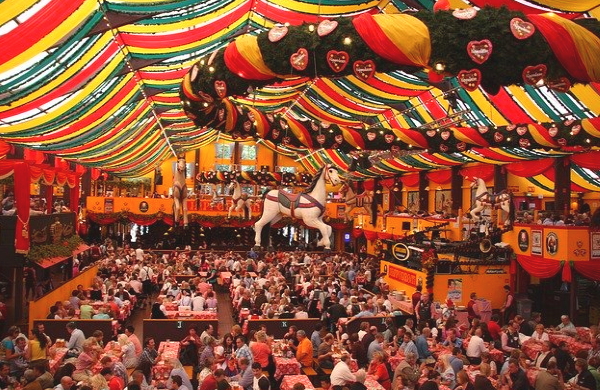
In order of size are the large marquees (in brackets the brewery): Paulanerfesthalle, Hackerfestzelt, Augustinerbräu, Schottenhammel (Spaten), Braurösl (Hacker-Pschorr), Armbrustschützenzelt (Paulaner), Ochsenbraterei (Spaten), Löwenbräu-Festzelt, Schützenfestzelt (Löwenbräu), Hofbräuzelt, Fischer-Vroni (Augustiner), Hippodrom (Löwenbräu). These tents have a total of about 70,000 seats. Almost all tents have beer gardens with many more 1,000 seats.
In addition, there are many smaller tents, the most famous are the wine tent, the chicken and duck roastery Wildmoser and Hochreiter’s Haxnbraterei.
Rides and showmen: The Wiesn, as the most important amusement park in the world, has over 100 attractions of this kind to offer. Many have a long tradition, every year there are a few new ones.
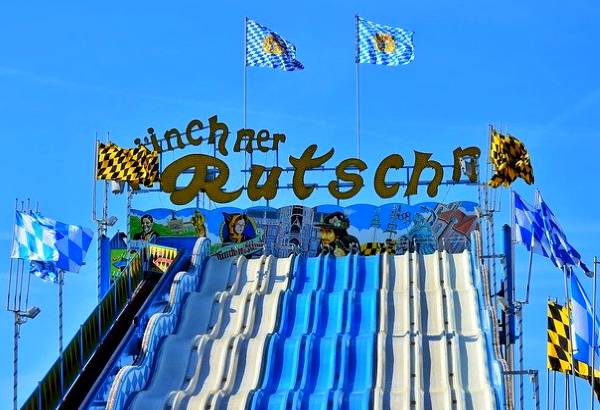
Well-known rides are the over 60-metre high Power Tower, roller coasters and the like such as the Euro Star, Star World, Ferris wheel and the Olympic loop. Of course there are also the classics: ghost trains, shooting galleries, can throwing, ship swings and much more. Every year there is something new.
Tip: There is now a Ferris wheel in Munich all year round: Our article
Food: In all marquees there are also smaller and larger meals. Mostly there are Bavarian classics and Oktoberfest celebrities such as ox on a spit, half chicken, half duck and plugfish. As snacks there are Weißwürste, Schweinsbratwurst (pork sausages), Schmalzbrote, radishes (radish or radishes) with salt, giant pretzels. In the tents the food has become very expensive. Outside the tents it is a bit cheaper at the many stalls and snack bars. Here you can get fish sandwiches, hamburgers, hot dogs and much more. Very popular are also the sweet stands with roasted almonds, cotton candy etc. In the last few years many stands with non-Bavarian food have been added (kebab, gyros, Thai, former Yugoslavian etc.)
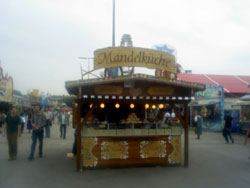
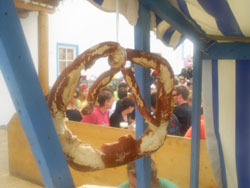
Prices: Unfortunately, Oktoberfest is expensive and prices continue to rise from year to year. Since the number of visitors and sales continue to increase due to popularity and the area of Theresienwiese is not growing, there is hardly any price pressure. The prices have now reached a level that is around 30-50% higher than at comparable events. The price of beer is still limited: a liter (1 liter) of beer will cost around 13 to 15 euros in the large tents in 2024. Food has become extremely expensive, especially in the tents. You can hardly get enough for less than 20 euros. Over €25 for a good meat dish with side dishes is more realistic. If you’re running out of money: Several ATMs are set up at the Oktoberfest. Smoking has been banned in the tents for several years.
Traditions
Tapping: The Oktoberfest traditionally begins on a Saturday at 12 noon. The first barrel is tapped by the Mayor of Munich (currently Dieter Reiter, SPD) at this time with the words „o’zapft is“. (it is tapped) tapped.
Clothing: Many Bavarians and increasingly also tourists from overseas come with Lederhosen or Dirtl. Very popular are also in recent years everywhere on the Oktoberfest buyable „Wieshüte“ and T-shirts, which are mostly related to the theme beer.
Moving in of the landlords: The first procession starts on the opening day at 10:30 a.m. From the Munich city centre the marquee landlords move to the Theresienwiese. Bands, brewery carts, carriages and so on.
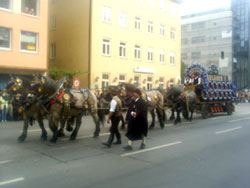
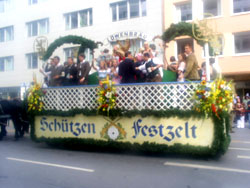
Traditional costume parade: Larger is the traditional costume parade on the 2nd day of the Oktoberfest (Sunday) with almost 10,000 participants (traditional costume clubs, shooting clubs, etc.) Worth seeing!
Top 10 Oktoberfest dishes
Pretzels (Brezn): Soft, salty pretzels are a classic Oktoberfest pastry and popular snack.
Roast chicken (Hendl): Grilled or fried chicken, often with a spicy crust, is one of the main meals at Oktoberfest.
Pork Knuckle: A large pork knuckle slow cooked or grilled until crispy and juicy.
Weisswurst: Traditional Bavarian white sausage, a mild boiled sausage made from veal and pork, served with sweet mustard.
Obatzda: A creamy cheese spread, often seasoned with onions, peppers and spices, served with pretzels.
Potato salad: Bavarian potato salad, often served warm and with a spicy broth or mustard dressing.
Steckerlfisch: Grilled fish on a skewer, usually trout or mackerel, seasoned and grilled over an open flame.
Käsespätzle: A type of cheese pasta, often served with onions and crispy fried onions.
Reiberdatschi: A type of potato pancake or donut, often served with applesauce or sour cream.
Sweet treats: Don’t forget the sweet delicacies such as Kaiserschmarrn, apple strudel and candied almonds.
The top 10 drinks at Oktoberfest are probably beer, beer, beer….
Oktoberfest Top 10: What is important
Here are 10 key aspects of Oktoberfest that create a unique and festive atmosphere.
Beer tents: Oktoberfest is famous for its large beer tents, each with its own atmosphere and offering. The tent is a central meeting point where visitors can enjoy traditional Bavarian beers.
Bavarian costume: Women’s dirndls and men’s lederhosen are traditional Bavarian costumes that are often worn at Oktoberfest and create a festive and cultural atmosphere.
Live Music: Beer tent bands and traditional Bavarian music provide lively entertainment in the beer tent, creating a lively and festive atmosphere.
Opening ceremony (tapping): The festival officially begins with the tapping of the first beer keg by the mayor of Munich, marking the beginning of the celebrations.
Rides and Games: There are numerous rides, games and attractions at the fairgrounds that provide entertainment beyond the beer tent.
Traditional Bavarian Cuisine: From pretzels and sausages to hearty dishes like pork knuckle and cheese spaetzle, Oktoberfest offers a variety of delicious Bavarian foods.
Parades: Colorful processions and parades with traditional costumes, floats and music showcasing Bavarian culture take place throughout the festival.
Ritual gun salute: The traditional gun salute commemorates the founding of the Oktoberfest and is a tribute to Bavarian history and culture.
Family-Friendly Activities: Oktoberfest is known for its beer celebrations, but there are also family-friendly activities, including a special area for children with rides and games.
Closing ceremony (gun shooting): The Oktoberfest ends with a traditional gun salute, which marks the end of the festival.